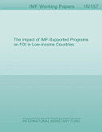Income Polarization in the United States
2016. jún. · International Monetary Fund
E-könyv
36
Oldalak száma
reportAz értékelések és vélemények nincsenek ellenőrizve További információ
Információk az e-könyvről
The paper uses a combination of micro-level datasets to document the rise of income polarization—what some have referred to as the “hollowing out” of the income distribution—in the United States, since the 1970s. While in the initial decades more middle-income households moved up, rather than down, the income ladder, since the turn of the current century, most of polarization has been towards lower incomes. This result is striking and in contrast with findings of other recent contributions. In addition, the paper finds evidence that, after conditioning on income and household characteristics, the marginal propensity to consume from permanent changes in income has somewhat fallen in recent years. We assess the potential impacts of these trends on private consumption. During 1998-2013, the rise in income polarization and lower marginal propensity to consume have suppressed the level of real consumption at the aggregate level, by about 31⁄2 percent—equivalent to more than one year of consumption.
E-könyv értékelése
Mondd el a véleményedet.
Olvasási információk
Okostelefonok és táblagépek
Telepítsd a Google Play Könyvek alkalmazást Android- vagy iPad/iPhone eszközre. Az alkalmazás automatikusan szinkronizálódik a fiókoddal, így bárhol olvashatsz online és offline állapotban is.
Laptopok és számítógépek
A Google Playen vásárolt hangoskönyveidet a számítógép böngészőjében is meghallgathatod.
E-olvasók és más eszközök
E-tinta alapú eszközökön (például Kobo e-könyv-olvasón) való olvasáshoz le kell tölteni egy fájlt, és átvinni azt a készülékre. A Súgó részletes utasításait követve lehet átvinni a fájlokat a támogatott e-könyv-olvasókra.






